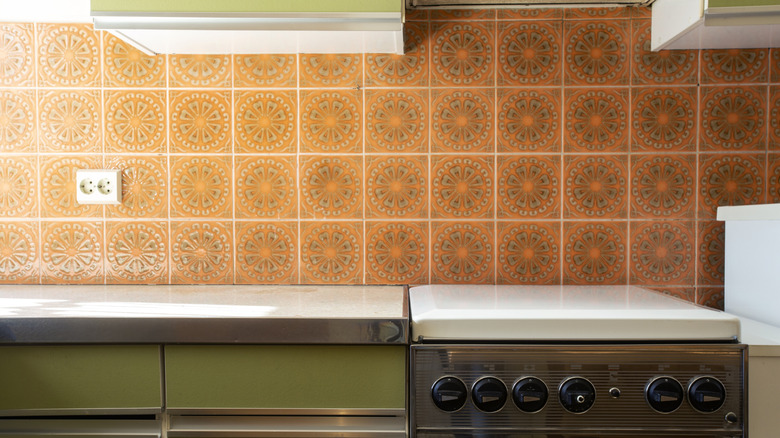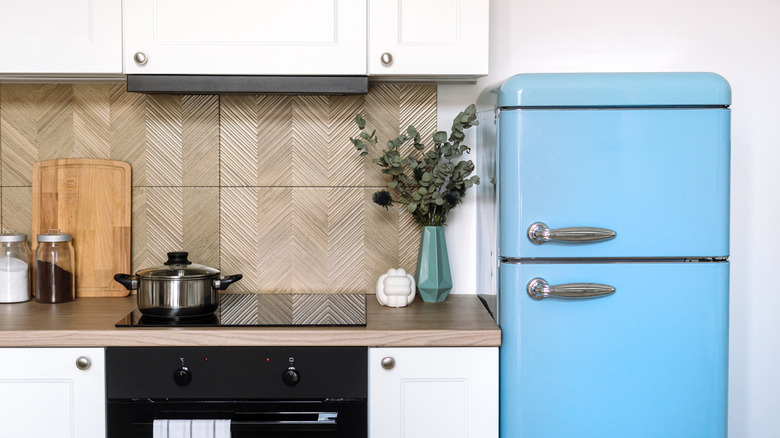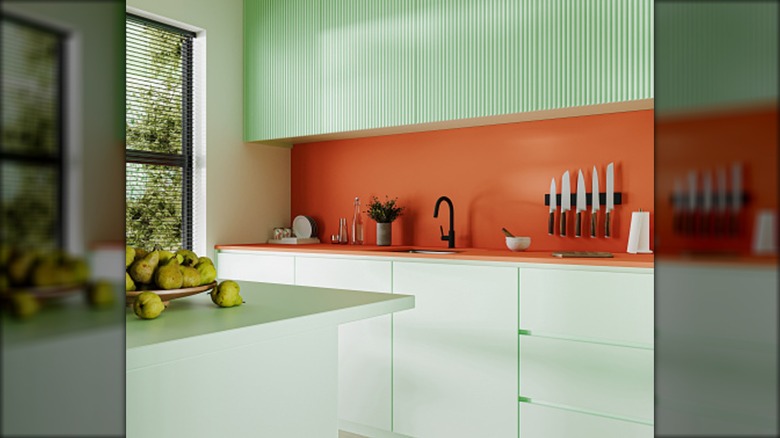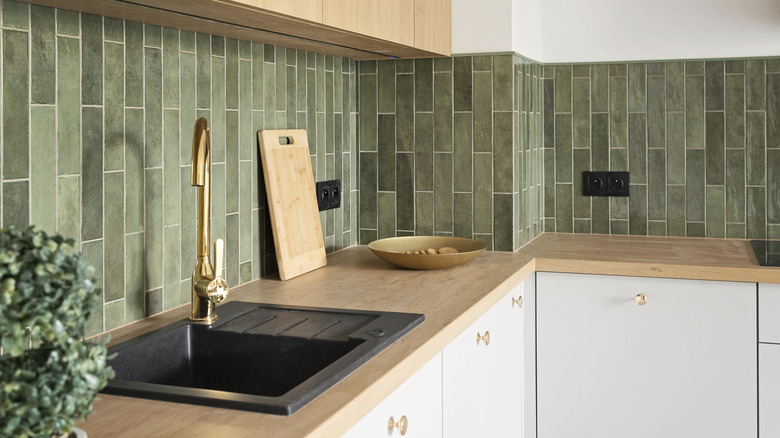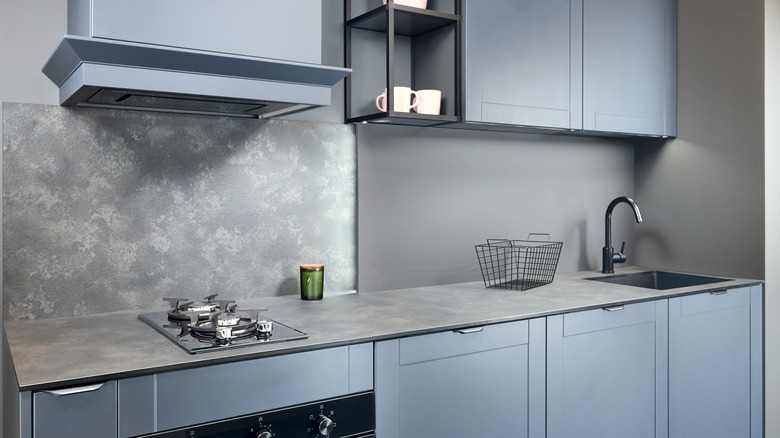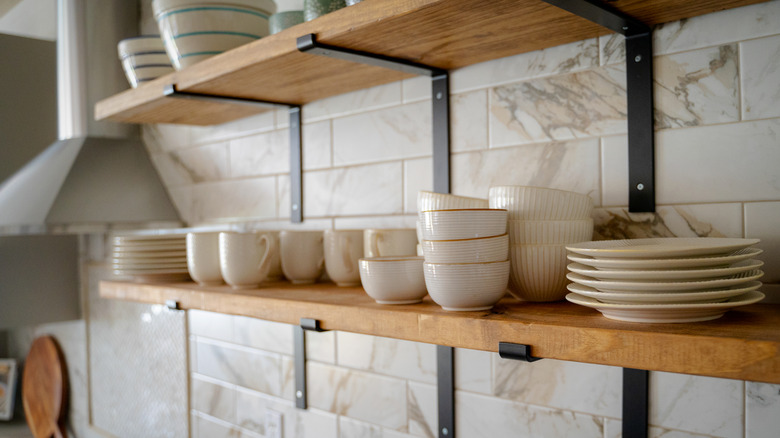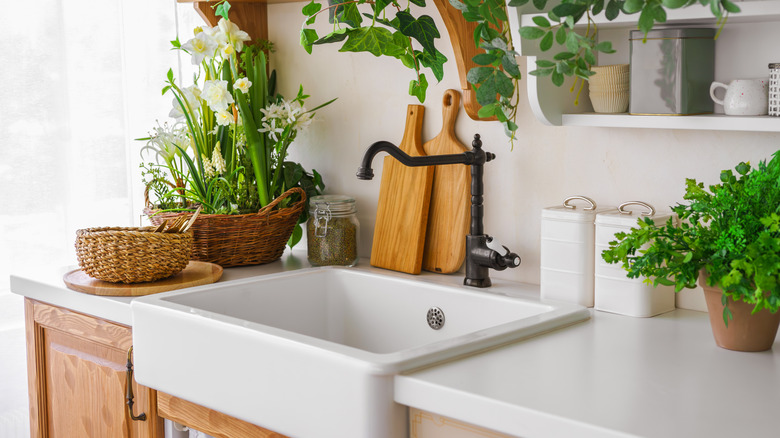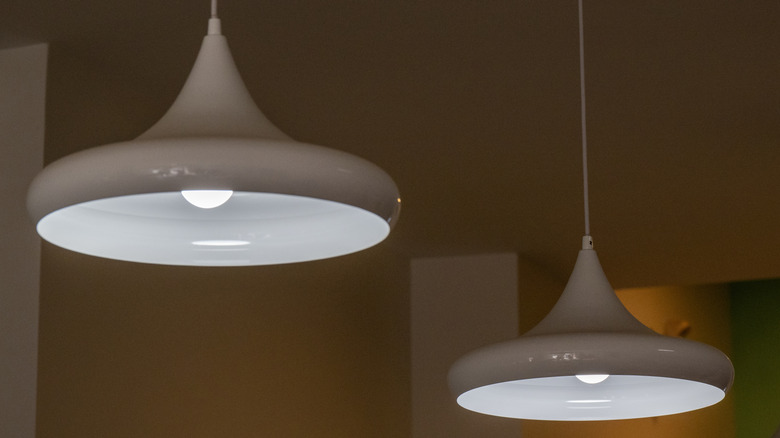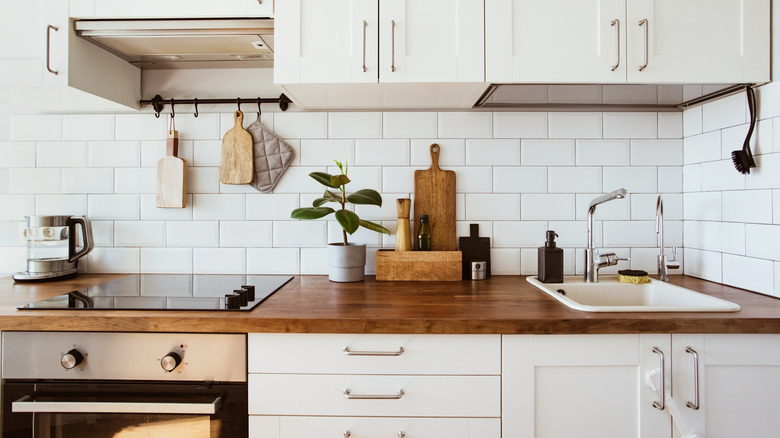15 Vintage Kitchen Designs So Charming They'll Never Go Out Of Style
While design trends come and go, you may have noticed an interesting phenomenon for kitchen looks — everything old becomes new again, even if it was once considered dated. From the return of natural wood tones to classic Victorian kitchen elements to mid-century's avocado green and terracotta hues, kitchen trends don't progress in a straight line; rather, they swing back and forth, reinventing yesteryear's styles with a modern look. There are just some elements about retro kitchens that are so incredibly charming that there's no way they will be gone for forever.
Renewed interest in vintage kitchen looks strikes a great balance between nostalgic comfort and modern style. Seeking durability and the throwback vibes of an era past, the resurgence of design items that we've identified, like black and white checkerboard floors, brass hardware, and statement tile, are sophisticated yet whimsical updates that imbue the soul of a vintage kitchen with the functionality of today's hustle and bustle. Historic charm is, in fact, timeless — something we're learning in the cyclical life of design.
Black and white floors
A staple of Art Deco era homes, black and white checkered floors bring a nostalgic, playful energy that can also be incredibly sophisticated in a modern home. Black and white floors are a way to add some pattern into a kitchen space without overwhelming it, which may be why it's making a huge comeback in modern houses. For a true nostalgic turn, opt for this alternating pattern in vinyl tile, but for a more elegant version choose a natural stone tile like marble.
Visually interesting backsplashes
Retro styles from funky mid-century kitchens, like colorful geometric tiles, bring a fun and powerful focal point into kitchen spaces. Hexagons, penny tiles, and even bright subway tiles with contrasting grout blend an old-school charm but with functionality when used on places like backsplashes, in conjunction with modern, sleek cabinets. A trend that's rooted in the ever-growing maximalism ("more is more") of today, loud and bold tiles prove that a touch of vintage flair is the perfect way to make a kitchen feel unique and stand out from the crowd.
Exposed brick
Another antique design, exposed brick in kitchens may have reflected more of a practical building than an aesthetic statement in the past, but nowadays brick makes for the perfect vintage kitchen. While historically brick walls were left exposed with the expectation that plasterers would finish off the wall, exposed brick became more prevalent because it was cheaper to execute than the finished product. Eventually, the practice caught on for its aesthetic value and became trendy in the mid 20th century. Today, historic exposed brick poses issues of insulation, but for aesthetics, play with a brick veneer in your spaces.
Farmhouse decor
A charming vintage vestige from ye olde farming days inspired by the old cottage aesthetic, rustic farmhouse kitchens are still all the rage. And while those authentic, antique farmhouse kitchen designs may be more suited to cooking over an open fire place than a stove, you can still embrace the bucolic vibe. What makes for a modern farmhouse in the kitchen? Think natural wood accents, crisp white porcelain tile, shiplap, and matte black hardware. If it's something you can find at the Magnolia Silos, it's probably a true representation of modern farmhouse kitchen decor.
Patterned tile floors
As you may have guessed from the bold tile ideas and checkerboard floors we discussed earlier, history didn't leave floors out of their design ideas either. Rather, in some eras the floor was the focal point of the kitchen. In the Victorian era and the early 20th century, intricately patterned cement tiles and high-contrast patterns were used to showcase craftsmanship in high-traffic areas, like kitchens and entryways. Today, modern homeowners are more likely to use patterned porcelain and durable vinyl to make the floors a visual anchor to otherwise simple kitchens.
Colored appliances
The 1950s, '60s, and '70s were a colorful kitchen fever dream, one known for brightly hued — and matching — large kitchen appliances like refrigerators and ovens, as well as smaller pieces like toasters and tea kettles. Going into the '80s and '90s, matching white appliances, and then stainless steel in later decades, took over home design. But a revival of retro-inspired colorful appliances just proves how trends, no matter how niche, can swing back full force. With brands like Smeg and Elmira leading the charge, this is the perfect time to infuse a unique pop.
Bold color
Speaking of color, vintage mid-century modern interiors did not shy away from vibrant pops of pastel hues, and that fun, flashy sentiment still endures in modern kitchen design for homeowners are aren't afraid of bold, loud kitchens. Mid-century homes were masterclasses in power color clashing — purposefully contrasting vivid colors to achieve a statement-making palette. For today's kitchen, you can start small with more curated pops like on the backsplash or hardware, but if you're ready to go all in, then march on with some full color clashing.
Brass finishes
Brass fixtures are a trend you'll see everywhere in 2026, but before designers like Netflix and HGTV's Jeremiah Brent made it the shiny, newest design idea, it was a vintage staple. With history rooted in more ornate Victorian designs in the 19th century, brass hardware in kitchens also experienced immense popularity in the 1950s to '70s. While its use in kitchen design slowed down entering into the 21st century, brass is having the ultimate redemption moment, popping up in faucets, cabinet pulls, and appliance hardware.
Earthy palettes
A foundational design trend of the mid century modern-era, sage or olive green, mustard yellow, clay orange, terracotta, avocado green, and rich brown were all the rage and readily used throughout the home, including in the kitchen. These earthy, organic tones leaned into other characteristically mid-century elements like woods and metals. Sometimes, these more muted tones were paired with a fun, power clashing color like teal for some design creativity. While today's use of these colors is less "all-at-once," these tones still work together in curated moments that are inspired by history but still fresh and modern.
Hardwood slab cabinets
Even though mid-century kitchens loved to play with pops of color or colorful appliances, simple slab cabinets made of hardwood also ruled the MCM-design roost. Giving a clean geometric line to doors and drawers, these solid wood doors void of any inlays or over-the-top millwork were as chic as they were mindfully constructed. Nowadays, your simple slab may be manufactured to achieve this look for less, but if you live in a mid-century home and have authentic, hardwood simple slab cabinets, cherish them — to get them new today would cost a fortune!
Laminate countertops
Laminate countertops are a controversial design topic given how many folks feel they look cheap. It's also not the most durable material and is prone to heat damage or scratches. However, laminate is another mid-century favorite that's stood the test of time given how budget friendly it is. Laminate is a way to upgrade the space and have fun with design without breaking the bank, making that natural stone aesthetic more accessible than a marble slab. A staple for DIYers, there are many ways to achieve a high-end kitchen with laminate countertops if you embrace the material.
Open shelving
A vestige of late 1940s kitchens and rooms when floating shelves became all the range, open shelving has been slighted in the past as an outdated trend. However, it's making a big comeback for its utility housing abnormally sized and shaped objects, as well as for its pleasing aesthetics. Zillow even reported that houses with open shelving sell, on average, three days faster than other homes. Open shelving's comeback game is so strong that original midcentury shelving units and bookcases are valuable finds at thrift stores and estate sales if you're looking for authentic pieces second hand.
Farmhouse sink
Harkening back to that 19th century farmhouse, farmhouse sinks are an enduring kitchen design element that's survived centuries of upgrades and updates. Beloved for their deep, oversized basin and visually interesting apron that gives some dimension to otherwise plain countertops, historically, farmhouse sinks were used for large amounts of water brought in manually which needed to be drained functionally and rather quickly. Today, these sinks are as much a part of the design decor as a functional appliance that can accommodate a whole lot of dishes in a modern home, with vintage call outs.
Funky pendant lights
Pendant lights in kitchens just scream mid-century modern, particularly in drop-shaped or round lights made from glass and synthetic polymers. In modern kitchens, pendant lights can add some fun retro whimsy, particularly if they're authentic to the mid-century modern era. For a more serious interpretation for kitchens that's still equally charming, try glass and brushed metal lights over focal points of your kitchen like the island. That's the best part about taking inspiration from the past: You don't have to cut-and-paste exactly as they did it back in the day — you can infuse your own style too!
Wood accents
Today's trending wooden accents in modern kitchens are a nostalgic nod to retro kitchen design, specifically mid-century to 1970s aesthetics. After decades of crisp, all-white kitchens, designers are warming up these spaces by bringing back the rich depth of natural wood. Like the aforementioned hardwood cabinets, wooden accents — like butcher block countertops, hardwood flooring that continues into the kitchen, or wooden decor — capture the heart of mid-century vibes but with modern appeal. There's an unpretentious, rustic charm to wooden accents, while still elevating the space to look more visually interesting than a cookie cutter kitchen.


